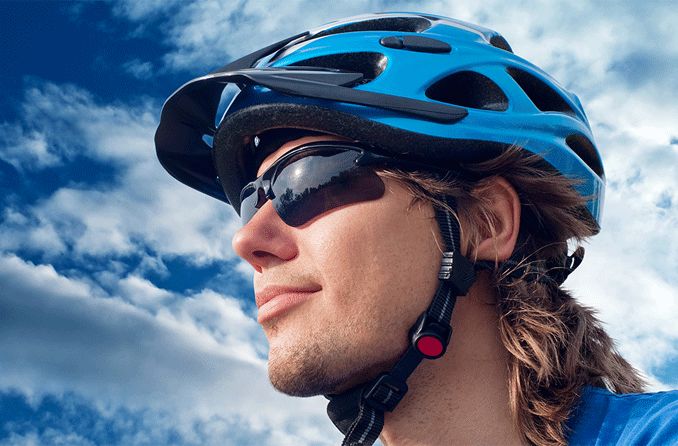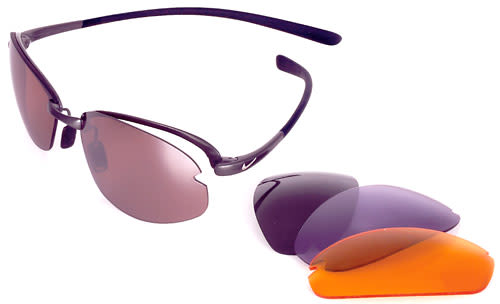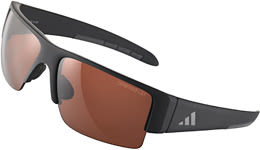Eyeglasses that enhance sports performance

Sports glasses are eyeglasses specially designed to:
Fit securely and comfortably during physical activity
Keep your eyes safe
Enhance your vision to give you an extra performance "edge" in the sports you love.
In most sports, vision drives performance. So, to excel during competition, you should make sure your eyesight is in top shape.
Even if you have 20/20 vision, the right sports eyewear can reduce glare and enhance contrast to help you see even better and react faster.
Sports glasses boost performance
Sports vision specialists agree that sports eyewear can have a profound effect on athletic performance. And coaches agree. For this reason, many professional sports team have an eye doctor on staff who is a sports vision specialist.
| Sport | Recommended Eyewear Features |
|---|---|
| Badminton | Protective sports eyewear (goggles or glasses made with polycarbonate or Trivex lenses). |
| Baseball | For batting and base running: Helmet with attached polycarbonate face shield.
For fielding: Sports goggles or sport sunglasses with shatter-proof lenses and an attached head strap. |
| Basketball | Wraparound sports goggles or glasses. |
| Bicycling | Performance sunglasses with anti-fog and anti-scratch lens coatings. |
| Boxing | There is no protective eyewear for boxing. Keep in mind the risks you take when stepping into the ring and make sure you get regular eye exams to check for scratched corneas ( corneal abrasion) and retinal detachment. |
| Fencing | Full-face protective mask made of a fine mesh of rigid metal. |
| Field hockey | All players: Sports goggles with secure head straps.
Goalies: Full helmets and face masks. |
| Fishing | Polarized sunglasses with anti-reflective coating. |
| Football (American) | Polycarbonate shield attached to helmet. |
| Golf | Polarized sports sunglasses. |
| Handball | Sports goggles with polycarbonate or Trivex lenses. |
| Hunting and shooting | Polarized, shatter-resistant shooting glasses. |
| Ice hockey | Full-face helmet. |
| Lacrosse | Form-fitting and padded face mask. |
| Paintball | Full-face helmet. |
| Racquetball | Sports goggles with polycarbonate or Trivex lenses. |
| Skiing and snowboarding | Ski goggles or wraparound polarized sunglasses with mirror-coated lenses. |
| Soccer | Sports goggles. |
| Softball | For batting and base running: Helmet with attached polycarbonate face shield.
For fielding: Sports goggles or sunglasses with shatter-proof lenses with an attached head strap. |
| Squash | Sports goggles or glasses. |
| Street hockey | All players: Sports goggles with secure head straps.
Goalies: Full helmets and face masks. |
| Swimming and diving | Nonprescription swim goggles and diving masks, prescription swim goggles or smart swim goggles. |
| Tennis | Sport sunglasses with a lightweight wraparound sport frame and polycarbonate lenses. |
| Track and field | Lightweight wraparound sport frame with polycarbonate lenses to protect against wind and debris. |
| Volleyball | Sports goggles or sunglasses. |
| Water polo | Swim goggles with polycarbonate or Trivex lenses. |
| Please read our Sports Sunglass Lens Tint Guide » | |
Sports glasses, goggles and eye protection
Experts agree that most sports-related eye injuries can be prevented if athletes wear protective eyewear, such as safety goggles with polycarbonate lenses.
Ski goggles should be considered a must on the slopes to reduce glare and protect your eyes from intense UV rays, and face shields (either "cages" or clear polycarbonate shields) should always be worn by catchers in baseball and anyone playing hockey or other sports with fast-moving objects that could strike your eyes.
Although children may resist the idea of wearing safety glasses during sports, parents and coaches should insist on it. It takes only a second for a sports injury to cause permanent vision loss in an unprotected eye.
And eye safety during sports is not just for kids — virtually anyone who plays active sports should wear sports glasses for eye protection and vision enhancement.
Also, never wear everyday "dress" eyeglasses during sports. Regular eyeglasses are not made to the same protective standards as safety eyewear. The lenses may shatter under impact and cause a serious eye injury.
Likewise, eyeglass frames that don't qualify for use in sports or safety glasses can break upon impact or cause the lenses to come loose and damage your eyes or face.
Another danger during outdoor sports is overexposure to ultraviolet (UV) radiation from the sun. UV rays have been linked to eye diseases such as cataracts and ocular tumors.
Overexposure to UV radiation also can cause a painful sunburn on the surface of your eyes (called photokeratitis) that can lead to long-term damage to the cornea.
Snowboarders and skiers should always wear tinted goggles or sports sunglasses, since UV rays bounce off snow even on cloudy days. Boaters and sailors, too, need protection from UV rays that reflect off the water.
Sports sunglasses: Choosing the best tint
You can choose from an almost endless variety of lens tints for sports sunglasses. Selectively filtering glare and certain colors can cause objects of a particular color on a specific background color — like a ball against the sky — to appear with greater clarity and contrast.
Tinted lenses that enhance the color yellow are desirable particularly in tennis, where they heighten the color and contrast of the ball against the sky or stadium walls.
Different lens tints can enhance specific colors for golfers, skiers, trap-shooters and other sports enthusiasts.
For example, golf glasses with copper-colored lenses enhance the contrast of a white golf ball against the sky and the green background of fairways and greens.
Some professional baseball players wear amber-tinted baseball glasses or sports contact lenses to help filter out blue light and increase their ability to see a baseball more clearly against the sky.
Amber or rose-colored ski goggles enhance soft grays that mark shadows on a ski slope. Because these shadows indicate ridges or bumps in the surface, increasing the visibility of these slope changes is a big benefit for skiers and snowboarders.
Reducing glare and adjusting to changing conditions
Polarized sports sunglasses reduce glare so athletes can see more clearly and react faster in bright conditions. Anti-reflective (AR) coating is another glare reducer that should be applied to the back surface of sports sunglasses to eliminate sunlight reflecting off the back surface of the lenses when the sun is behind you.

Nike Hyperion III frames have two polycarbonate lens options, for sunny and flat light conditions.
Photochromic lenses help athletes see their best in a variety of lighting conditions. These lenses darken automatically in response to sunlight and the lens tint fades or disappears when in shade or after the sun sets.
The largest manufacturer of lightweight, impact-resistant photochromic lenses is Transitions Optical. Because of the popularity of this brand, photochromic lenses sometimes are called "transition lenses." But several lens manufacturers offer photochromic lenses for sports glasses. Your eye doctor can advise you of the best type and color of photochromic lenses for your sports vision needs.
Photochromic lenses are terrific for golf, where you move frequently from bright sunlight to shade or dusk during the course of a round. For the ultimate light-control sports glasses, many eye care professionals recommend adding anti-reflective coating to photochromic lenses to eliminate glare from the "bounce-back" of light from the back surface of the lenses when the sun is behind you.
Personalized sports eyeglasses
Getting the best possible eyewear to maximize your sports performance starts with your eyeglass prescription. Schedule an eye exam with an eye doctor near you and discuss with your doctor which sports you enjoy.
Next, see a qualified optician for additional advice about the best frames and lenses for your sport and to see samples of different lens tints. Your optician's help in frame selection is critical, because the proper fit of sports eyewear is very important for both safety and comfort.
When it comes to achieving your personal best in sports, remember that excellent vision is a key factor in athletic performance. Put sports eyewear at the top of your list when you shop for gear and accessories to enhance your game.
READ NEXT: What are the best sports sunglasses for men?
Page published on Wednesday, February 27, 2019







